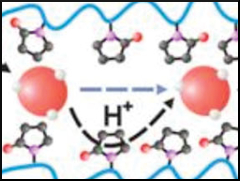The development of proton exchange membranes (PEMs) with good performance is critical for electrochemical energy devices such as fuel cells. Current PEMs, as for example Nafion, are limited by high costs and their environmental incompatibility. As an alternative inorganic proton donors with high conductivity and thermal stability, heteropolyacids (HPAs), such as phosphotungstic acid (H3PW12O40, HPW), have attracted much attention. HPW is successfully incorporated into inorganic materials or polymer matrices. However, resulting PEMs still lack a sufficient stability.
Yan Xiang, Beihang University, Beijing, China, and colleagues used a simple one step self-anchoring approach by fixing HPW on a polyvinylpyrrolidone (PVP) and polyethersulfones (PES) matrix, creating a novel hybrid based PEM. At a HPW content of 30 wt %, high proton conductivity of 0.066 S/cm at 60 °C is achieved under fully hydrated conditions. This is comparable to Nafion115 under the same testing conditions. The membrane is stable under a continuous flow of deionized water on both sides of the PEM for a testing period of more than 500 h.
This HPW-based PEM overcomes flaws of previous matrices, making it a promising candidate for an alternative to Nafion.
- A Self-Anchored Phosphotungstic Acid Hybrid Proton Exchange Membrane Achieved via One-Step Synthesis
Shanfu Lu, Xin Xu, Jin Zhang, Sikan Peng, Dawei Liang, Haining Wang, Yan Xiang
Adv. Energy Mater. 2014.
DOI: 10.1002/aenm.201400842



